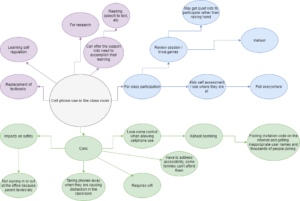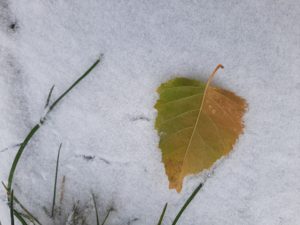#edcampuvic 2020
My teaching cohort were very fortunate to be invited to #edcampuvic 2020. This was a different kind of learning experience compared to other professional learning opportunities. Basically, we had the opportunity to meet with other teachers and teacher candidates and talk about experiences, questions, and ideas towards using technology in the classroom. The flexible structure of this event allowed for conversations to naturally wander to all aspects of the topic leading to a well rounded discussion.
I participated in the “using cell phones in the classroom” breakroom, and our conversation spanned many different aspects around the topic. In order to summarize our conversation, I felt that I needed to incorporate a visual component.

What I found the most important about our conversation on the use of cellphones in the classroom is dependent on the teacher and on the students.
As the teacher, you can either use cellphones as a learning tool or banish them. Using cellphones as a learning tool, allows you to address the fact that students want to use them and that it can help engage students in the room. Cellphones can be a tool to produce the diversification in learning with the use of app that help students with reading or writing. Cellphones can also be used as a tool for students to play review games (like Kahoot) or make flashcards. Lastly, they can be a way to poll the room, and allow students to anonymously respond to how they are feeling about the content.
What I really enjoy about these uses of cellphones in class, is that they provide a medium for students that are shy, quiet, or uncertain about their answers or are embarrassed to say they don’t understand to in a way voice those opinions. I also think, at the start of a year or semester, it may allow for a way for students to start feeling connected in the classroom.
On the flip side of this, cellphones can also be a teachers worst nightmare- depending on the students present in the class. Sometimes cellphones will completely distract students in the class, can be a source of bullying, and a source of social elitism. They can even be a problem when a teacher is trying to incorporate them into the learning experience. For example, when there is the opportunity to type in answers while remaining anonymous then some people develop the idea that they can make inappropriate comments with no consequence. Therefore, I think that teachers need to pre-face the use of cellphones and set up clear expectations and guidelines in how they are to be used.
Now, how would I bring cellphones into my own classroom…
From what I have learned today, I think that I would allow cellphones to be used. What I would want to approach at the start of a term, is the idea of self-regulation. I feel that it is essential for students to learn when to, and when not to use their cellphones. I also want to give students resources that they can use on their phones that can benefit their own learning, and help individualize their learning styles. However, what I will also say, is that I have not actually tried to teach a lesson and try and control cellphone use, so maybe this method of listing my expectations is not going to be enough for grades 8-10 students.
However, the use of cell phones is also dependent on the school that you are working in. Is there wifi that students can use? If not, then asking students to use data is not producing an equal learning opportunity, because some students may not have the same access to data plans, or cell phones like other students. So, if cell phones are being incorporated then I think you also need to be offering the use of mobile computer/ tablet lab if it is accessible in the school. Or else, by using cellphones you are just providing an even larger gap in learning between the people that have and the people who do not.
